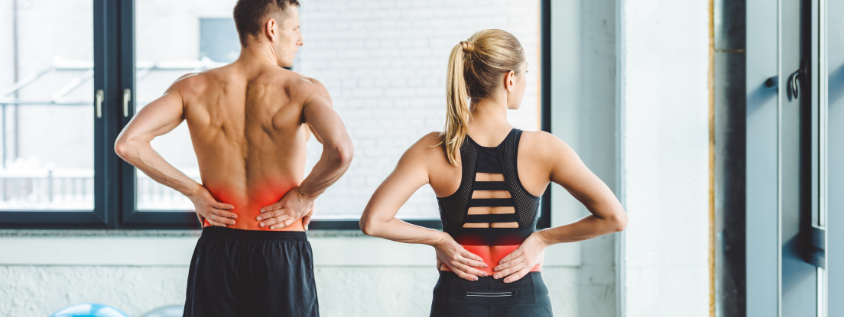
BACK PAIN: SYMPTOMS, CAUSES, REMEDIES
We call it "the disease of the century" because, according to existing studies, no less than 80% of the population will suffer back pain at some point in their lives. The term back pain encompasses numerous problems, such as chronic low back pain, sciatica and disc herniation, all with one element in common: pain is localized in the spine.
Almost all people may incur back pain that interferes negatively with work, daily activities or leisure. Back pain can be caused by various causes such as poor posture, psychophysical stress or overweight. Let’s find out more about different types, its causes and remedies.
Types of back pain
Back pain can be classified into three groups. If the pain is localized in the upper back or in the neck bones (cervical column) it is said in medical terms neck pain. If the pain is localized in the lower back, around the lumbar vertebrae, it is called lumbago (lower back pain. Finally, if the pain is localized in the central part of the back, around the thoracic vertebrae, it is called dorsalgia (upper back pain).
- Cervicalgia (neck pain) is a pain that affects the cervical column that usually passes in a few days and is often associated with a wrong posture or stress.
- Lumbar pain affects the lower back and can prevent even the smallest movements. It is often caused by sudden or prolonged movements or by staying in the same position for too long. It is the most common type of back pain.
- Upper back pain is the pain that affects the central part of the back up to the base of the neck, around the thoracic vertebrae. The thoracic spine, which acts as a support structure for the thoracic cage, is composed of vertebrae that are less mobile than the others and any problems in this area may cause pain and/or a feeling of stiffness or restriction in movement.
Back pain causes
Back pain is usually the result of multiple causes, sometimes joined together. It may be due to:
- an incorrect posture held for a long time;
- excessive muscle tension due to psychophysical stress;
- a problem related to the consequences of overweight and sedentariness;
- cold, humidity, muscle tears, excessive efforts.
The diagnosis of back pain is definitely clinical and requires an accurate medical examination that can be supported by instrumental examinations (X-ray, MRI and CT). The doctor will indicate the most suitable therapeutic path: physical therapies (such as laser, tecar, ultrasound, etc.), individual motor rehabilitation therapy, therapeutic massages, vertebral manipulations, manual therapies with vertebral mobilizations, infiltrative therapies, medical gymnastics classes.
How to relieve back pain
To avoid back pain it is necessary to take and maintain correct postures. Only a correct postural attitude allows you to distribute the weight of the body more evenly avoiding the stretching of the muscles. If you are standing, you should keep your head high, with your eyes looking in front and not on the ground. In this way, the neck is erect and the weight of the head well distributed throughout the column.
Sitting incorrectly can lead to back pain. The desk or work table should not be too high or too low, so as not to force you to tilt forward or backward. The chair should be adjustable in height, to allow the feet to rest well on the ground, and should have a slightly curved backrest at the height of the lumbar region of the spine.
In case of overweight, it is helpful to try to lose the extra pounds through both physical activity as well as proper nutrition. A natural diet is able to support the healing processes of the organism. You should prefer whole grains, legumes, fish, oilseeds, vegetables and seasonal fruit than unnatural foods such as packaged foods, sugary drinks and anything containing additives.
A plant-based pescatarian diet may help your body to physiologically fights against chronic inflammation.
Exercises for lower back pain
It is essential to avoid prolonged inactivity and to maintain a minimum level of physical activity. Swimming, for example, is particularly recommended for the back but activities such as yoga or pilates, which strengthen the center of gravity and promote stretching, are also highly recommended.
Stretches for the lower back pain is extremely important to prevent it. It is advisable to focus on exercises that strengthen the upper back, such as press-ups, and improve the flexibility of the spine with exercises that involve the curling and relaxation of the back being on all fours ("cat and cow position").
With regard to stretches for the lower back pain, we suggest two simple exercises reminding you that they must be performed with delicacy and precision:
- First exercise. Lie on the ground on your backs. Bring your knees to your chest, bringing them as close as possible with the help of your arms. Hold the position for 20 seconds and then relax for a few seconds. Repeat twice more.
- Second exercise: On the ground on all fours (in genuflection, place your hands forward, resting them on the floor at shoulders height). Exhale by bending the spine upwards until the lungs are completely emptied. Inspiring you return slowly to the starting position flattening your back. Repeat 5 times.
Did you find this article interesting? Let us know and share it with your friends! :)
